Today's post is a guest submission by longtime reader David Thomson. Many thanks to David for offering us his thoughts on a subject with a lot of meaning to him: typewriters. (It makes me want to go out and order one!)
I have been a long time fountain pen user, having convinced my father to purchase a Montblanc 22 for my graduation from High School 40 years ago. Something about writing with a fountain pen just worked better for my handwriting. Ballpoint or gel pens do not work as well for me, and I avoid them.
During my child-rearing years, I almost exclusively used Pilot Varsity pens. When you have small children around, cheap, disposable, and reliable works well. A couple of years ago, I came upon Brad’s site, and – as many of us have – fell down the rabbit hole. After starting with the Safari, and progressing up the chain, I have found a sweet spot with Franklin-Christoph pens, usually eyedroppered with a steel stub nib or Masuyama grind. I have bought and sold a couple of dozen pens and now have about a dozen with almost 30 inks. Other than the F-C pens, I have a Lamy 2K, Pilot 912, Pilot CH74 (orange), Platinum Nice Pur, and a three Delta pens. I’m pretty happy there, and remain a devoted fan of the Pen Addict Podcast, the Anderson’s Blog, and – of course – The Gentleman Stationer.
Like most of us, I have been noticing over the last several years that being a heavy user of technology can be alienating, and can lead to my days being chopped up into tiny fragments, with my attention fractured. This is not good, since my work – I am a University Professor – requires some concentrated thinking time on a regular basis. Grading student papers, conducting scholarly research, etc.
In today’s world, however, eschewing technology is simply unrealistic. We now have an extraordinary research tool, communications device, and source of entertainment at our fingertips. It would be impossible to do my job – work that I love – without using my devices many times per day. To respond to student inquiries, to keep in touch with colleagues, to prepare for classes, and to research and write scholarship. I am a heavy user of Mac keyboards on five different machines.
But I have felt for some time that something was missing. That the temptations were sometimes too great at the computer to focus on something other than my writing. And while I am no crazy lefty or anti-government crank, I have increasingly been made to feel that anything I put into a computer’s memory is somehow immediately discoverable by whichever government (or just plain snoop) might want to drop in and look around. While I have nothing to hide, most of us like to try out ideas before letting them see the light of day. It is the way humans operated with ideas for thousands of years, up until the last 30 or so.
My father – also a University teacher for part of his career – wrote me letters every week for 40 years. My parents divorced when I was young, and he spent many years in journalism after the divorce. I saw him on Saturdays, and he wrote the letters as a way to keep in touch. Each one of these letters - approximately 2,000 in total – were typewritten, and I kept every one. He never converted to the PC or texting, but instead used the same Royal FP typewriter he was issued at his job in 1962 (and given when he retired). If he had switched to email I might have lost some of them, but I still have each typewritten letter he sent to me stored in plastic tubs in the basement of my home.
My father died two years ago at the age of 89. He lived a good life, and I miss him, but I really miss his letters. They were newsy, about his golf game, and about the political scene (he lived in D.C., so hard to avoid that). When I miss him, I can go get some of his letters from the basement, and hear his “voice” again.
His widow, my step-mother, has avoided cleaning out his study, and I don’t blame her. A hard thing to do after 43 years of marriage. But when she gets to that task, she knows I would like his old typewriter. Just as a memento – I couldn’t type anything on it. It has been silenced by his absence, and should stay that way.
Thinking about his typewriter got me to do some research on the subject. And guess what? There is a surprisingly large and devoted group of typewriter collectors and users, not unlike the fountain pen community.
Typewriters have a few advantages over computers, I have discovered. For many of us, writing on a computer keyboard allows us to edit and correct mistakes as we write, which can interfere with the writing process. It is generally much better to write without the ability to go backwards and correct as you go. A typewriter makes you just keep on writing and then makes editing/reworking your writing as a fully separate step. As a result, when using a typewriter you have to think more carefully and more deeply while you are writing, and the writing improves as a result.
Many contemporary writers still chose to use a typewriter. Among them are David McCollough, Robert Caro, Woody Allen, and Paul Auster. They chose to write first drafts on a typewriter very intentionally – it helps them to think and compose at a pace they believe produces better writing. There are wonderful video clips of each of these writers describing their process, all easily found. The actor Tom Hanks is a user of typewriters, and he has a large collection of them. In an effort to bridge the Analog/Digital divide, he has developed an app that recreates the typewriter experience on the iPad.
There is a terrific recently published book called The Typewriter Revolution, written by Richard Polt, also a University professor and a typewriter collector and restorer. He created The Typewriter Manifesto, which attest to the benefits of writing “old-school.” There are Type-ins – gatherings of typewriter enthusiasts – and street poets who use a typewriter to compose poetry on-demand.
I myself now have a growing collection of typewriters, and the first draft of this post was written on an Olympia SM9, manufactured in 1966 - over 50 years ago. It is a fine machine, all metal and precise German engineering. I also have an earlier Olympia – the SM3 – from 1958. And a Smith Corona from 1957 and another from 1934. Recently I found a Remington portable in an Antique store from 1928. It is almost 90 years old and it still works perfectly.
The parallels between the fountain pen community and the resurgent typewriter community are seemingly many. In fountain pens, we appreciate beautiful design, and we are not afraid to adhere to and even celebrate a technology that is perceived by many to be out of date and obsolete. We appreciate different functionality between different models, as well as designs from many years ago, items no longer made and not likely to be. And we enjoy tinkering with and fixing up things that many would overlook or discard. You can get beautiful examples of typewriters on eBay in great shape in the range of 50-75 USD.
There are blogs for typewriter enthusiasts, as you might suspect. Many of them are “Typecasts” – which are actually typewritten posts of which a digital picture is taken and posted to the blog (that’s Analog/Digital right there!) Also, there are a few bloggers that combine an interest in fountain pens and typewriters. And I recently learned on an episode of the Pen Addict that Ana Reinert sold out a small collection of typewriters at the Arkansas Pen Show.
Despite the growth of Typecasts, one of the great advantages for many is that a typewriter is not connected to the Internet, and thus no one can see or read or judge what you are writing unless you decide to show them or put it in an envelope and affix a stamp.
So the resurgent typewriter community is exploring the Analog/Digital divide in a number of interesting ways, and has a lot in common with the fountain pen community. Many fountain pen users have been discovering that sometimes it is better to make the Analog choice, and I have found – somewhat to my amazement – that turning to a typewriter to bang out first rough drafts of my writing and presentation notes to work very well.
I just wish I could tell my Dad.
Disclaimer: The thoughts and writing in this post are all David's, slightly edited by me (Joe) for length and to add links to certain web content and books that he mentions. Some of the links may be to sponsors/affiliates of this blog.


